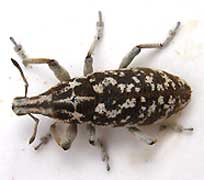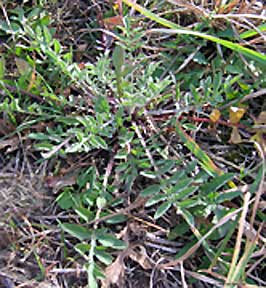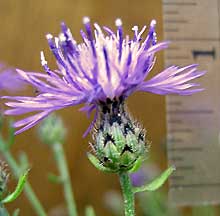
JEFFERSON CITY - They are tiny, tireless, hungry, and environmentally friendly--except to one invasive weed.
They're called seedhead weevils, pictured at left, and the Missouri departments of Transportation and Conservation, along with the University of Missouri Extension, are using them to help control Missouri's newest noxious weed--spotted knapweed.
The weevils, Larinus minutus and Larinus obtusus or "Larrys" as some researchers like to call them, are small, flying, dark brown or gray bugs with a long snout. They can spread throughout a knapweed patch in a few years.

"Knapweed infestations occur in poor soils along rock cuts and steep slopes, and the weed, pictured at right as it appears in November, produces an herbicide within its roots that kills nearby plants," explained Chris Shulse, MoDOT roadside manager. He explained that each plant can produce more than 1,000 seeds that remain alive in the soil for nearly 10 years and are easily spread by mowers in late summer.
Spotted knapweed (Centaurea Stoebe micranthos) is a weed native to Europe that was introduced to the United States in the late 1800s. It was first spotted in Southwest Missouri in 2002 but is now found throughout southwest and south central Missouri mostly south of Interstate 44 and two multi-county areas in the east central and north central parts of the state. A chart shows that almost half of the counties of Missouri harbor the weed with Jasper and Newton counties among them.
"Needless to say, this plant is one tough character to control," Shulse also noted.

The noxious weed, pictured at left as it appears in late June, resembles the garden flower called bachelor's buttons. Although pretty, if knapweed is not controlled, Shulse warns, it can spread onto private lawns and pastures, where it significantly reduces the available forage. MoDOT has found that knapweed is hard to eliminate with herbicides alone because it grows in difficult to reach areas, often extending beyond the roadside onto private property.
MoDOT began to release the weevils on roadsides in southern Missouri in 2008 and in northeast Missouri in 2009. In addition to the 2009 release, MoDOT introduced the hungry bugs to infested areas last month. They typically are released in July when knapweed is in bloom so the females can lay eggs on the flowers. When the eggs hatch, the larvae go to work, eating the flower and seeds, reducing the plant's ability to reproduce. A single larva can eat every seed in a flower.
Another bug is weed's predator
A second knapweed-controlling weevil that has been introduced is the root-boring Cyphocleonus achates, or "Cy." Shulse describes it as larger, doesn't fly well and its color helps it blend into rocky ground. These insects are released in August, when females lay eggs on young knapweed plants. The larvae burrow into the roots, causing the plant to die within a few years. Researchers documented reductions as high as 99 percent in knapweed patches where "Cy" took up residence, Shulse said.






Comments